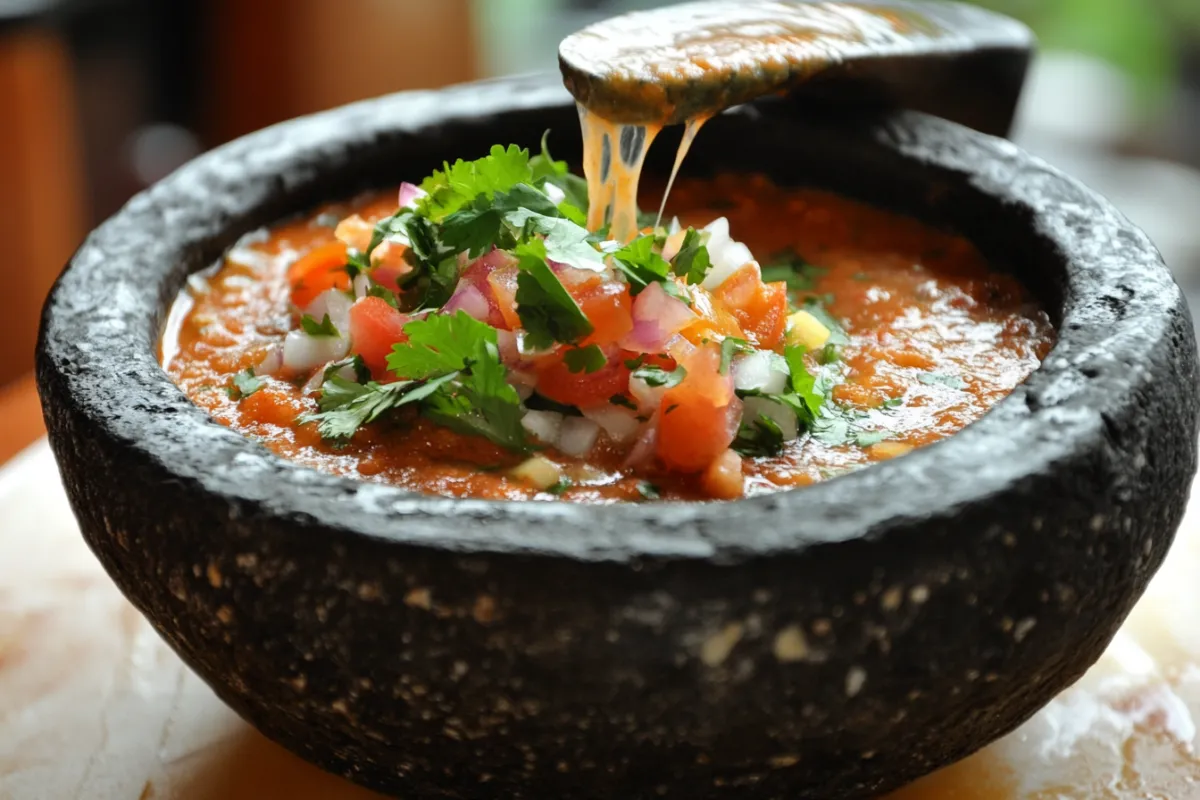What is a Molcajete Dish? The Complete Guide to Mexican Culinary Tradition
The molcajete serves as much more than a simple kitchen tool in Mexican cuisine. For centuries, it has been an essential part of preparing and serving a range of traditional dishes. While many associate the molcajete with the volcanic stone mortar and pestle used for grinding spices, it also refers to a popular dish that chefs serve sizzling hot in the same stone vessel. This dish typically combines grilled meats, seafood, vegetables, and rich, flavorful salsas, creating a unique dining experience.
But what exactly makes a molcajete dish so special? Is it just the presentation, or does the iconic stone vessel itself enhance the flavors? In this comprehensive guide, we will explore everything about the molcajete dish—its history, ingredients, preparation methods, and why it continues to captivate food lovers worldwide.
History of the Molcajete Dish
The molcajete, as a tool, originated in ancient Mesoamerican civilizations such as the Aztecs and Mayans. These early cultures used volcanic stone mortars to grind spices, grains, and cacao. The stone’s porous texture made it ideal for grinding, as it could easily break down even the toughest seeds and fibers into smooth pastes and powders.
Historically, people viewed the molcajete as more than just a kitchen tool. It symbolized communal eating and shared meals. Families used it to serve food during celebrations, family gatherings, and ritual feasts. The stone mortar’s durability ensured its longevity, allowing it to be passed down through generations, transforming it into a family heirloom in many households.
Modern molcajete dishes build upon this rich heritage. They incorporate contemporary ingredients while maintaining the traditional style of serving food in the volcanic stone bowl. This design keeps the dish hot long after serving, enhancing flavors and creating a robust dining experience. For more insights into the cultural significance of Mexican cuisine, explore this guide on the history of traditional dishes.
What Makes a Molcajete Dish Special?
A molcajete dish stands out not only because of its presentation but also due to its unique cooking process. The volcanic stone, which composes the molcajete, plays a critical role in flavor development. You can heat the stone to extremely high temperatures, allowing the food to continue cooking and sizzling even after serving. The heat retention of the stone bowl ensures that the ingredients meld together, making every bite more flavorful than the last.
Additionally, the molcajete adds a unique texture to the food, especially when chefs prepare salsa. The rough surface of the stone grinds ingredients like tomatoes, onions, garlic, and chiles in a way that modern blenders or food processors cannot replicate. This method enhances the natural oils and flavors in the food, creating a richer, more complex taste.
The experience of eating from a molcajete further elevates the dish’s appeal. The sight of sizzling meats, molten salsa, and vibrant vegetables, all served in a stone vessel, transforms a simple meal into a sensory feast. Learn more about the best ingredients to use in Mexican cooking.
What Ingredients Go Into a Molcajete Dish?
A traditional molcajete dish can vary widely depending on the region of Mexico, but some common ingredients include grilled meats, seafood, vegetables, and flavorful sauces. The key to a great molcajete dish is the balance between the heat of the salsa, the richness of the meats, and the freshness of the vegetables.
Common Ingredients:
- Grilled Meats: Beef, chicken, shrimp, and sometimes chorizo are the most popular meats used in a molcajete dish. These are usually seasoned with traditional spices like cumin, paprika, and oregano before being grilled to perfection.
- Seafood: In coastal regions of Mexico, it’s common to find seafood molcajetes filled with shrimp, fish, and even octopus. These seafood variants offer a lighter, yet equally flavorful alternative to the meat-based dishes.
- Vegetables: Grilled or roasted vegetables like onions, nopales (cactus paddles), and peppers are a staple in any molcajete dish. The charred flavor of these vegetables complements the richness of the meats and adds a smoky depth to the dish.
- Salsas: The salsa in a molcajete dish is often made directly in the stone bowl itself. Ingredients like roasted tomatoes, garlic, chiles, and onions are ground into a thick, flavorful sauce that coats the meats and vegetables.
- Toppings: Molcajete dishes are often finished with toppings like queso fresco, avocado slices, grilled jalapeños, and fresh cilantro. These add texture and brightness to the rich, savory elements of the dish.
- Tortillas: No molcajete dish is complete without a side of fresh, warm tortillas. They are used to scoop up the meats, vegetables, and salsa, making every bite a complete, flavorful package.
How to Prepare a Molcajete Dish at Home
Making a molcajete dish at home may seem intimidating, but with the right preparation, it can be a rewarding experience. The first step is to season your molcajete if it’s brand new. Seasoning removes any stone dust and prepares the surface for grinding.
Seasoning Your Molcajete
- Rinse the Molcajete: Start by rinsing the stone with warm water. Do not use soap, as the porous nature of the stone can absorb it.
- Grind Rice and Salt: Place a handful of uncooked rice and a pinch of salt in the molcajete. Use the tejolote (pestle) to grind the rice into a fine powder. This helps remove any remaining stone dust.
- Repeat Until Clean: Repeat the process until the ground rice comes out clean and white, indicating that the molcajete is ready for use.
Once your molcajete is seasoned, you can begin preparing your dish. Here’s a step-by-step guide to making a traditional Molcajete Mixto, one of the most popular variations of the dish.
Step-by-Step Recipe: Molcajete Mixto
Ingredients:
- 1 lb. grilled beef (sirloin or ribeye)
- 1 lb. grilled chicken breast
- 1 lb. shrimp, peeled and deveined
- 2 nopales (cactus paddles), grilled
- 1 onion, sliced and grilled
- 3 roasted tomatoes
- 2 cloves garlic
- 2 jalapeños, roasted
- 1/4 cup queso fresco
- Fresh cilantro for garnish
- Warm tortillas for serving
- Salt and pepper to taste
Instructions:
- Prepare the Molcajete: Preheat your oven to 400°F. Place the molcajete inside and allow it to heat for about 20 minutes.
- Grill the Meats and Vegetables: While the molcajete is heating, grill the beef, chicken, and shrimp. Season them with salt, pepper, and your choice of spices (paprika, cumin, oregano). Grill the nopales and onions alongside the meats until they are charred and tender.
- Make the Salsa: In a separate skillet, roast the tomatoes, garlic, and jalapeños until they are slightly charred. Transfer them to the heated molcajete and use the tejolote to grind them into a thick, chunky salsa. Season with salt and pepper to taste.
- Assemble the Dish: Carefully remove the hot molcajete from the oven and spoon the salsa into the bowl. Layer the grilled meats and vegetables on top of the salsa. Add slices of queso fresco and garnish with fresh cilantro.
- Serve: Serve the molcajete dish sizzling hot with warm tortillas on the side. The heat from the molcajete will keep the food warm as you enjoy your meal.
Variations of the Molcajete Dish
One of the great things about a molcajete dish is its versatility. There are endless variations to explore, each offering a unique take on the classic recipe. Here are a few popular versions:
1. Seafood Molcajete
This variation is common in coastal regions of Mexico. Instead of beef and chicken, it features grilled shrimp, fish, and sometimes octopus. The seafood is cooked in a rich, spicy tomato-based salsa and served in the hot molcajete bowl.
2. Vegetarian Molcajete
For those looking for a plant-based option, the vegetarian molcajete focuses on grilled nopales, onions, bell peppers, and avocado. Topped with queso fresco and salsa, this dish is just as hearty and flavorful as its meat-based counterparts.
3. Molcajete de Pollo
If you prefer a lighter version of the dish, you can make a chicken-based molcajete. Grilled chicken breasts are served with roasted vegetables and a mild salsa for a healthier take on the traditional recipe.
Why the Molcajete Enhances Flavor
The molcajete isn’t just a serving vessel—it actively contributes to the flavor of the dish. The volcanic stone is porous, which helps to grind ingredients in a way that modern blenders cannot. The friction created by grinding in a molcajete releases essential oils from ingredients like garlic, tomatoes, and chiles, resulting in a more intense, vibrant flavor.
Additionally, the molcajete’s ability to retain heat plays a key role in enhancing the dish. The high temperature allows the ingredients to continue cooking and melding together even after they’ve been served. This creates a dynamic eating experience where each bite is hotter and more flavorful than the last.
How to Care for Your Molcajete
Caring for your molcajete is essential to ensuring its longevity. Since the volcanic stone is porous, it requires special care when cleaning.
- Avoid Soap: Never use soap to clean your molcajete, as it can seep into the stone and affect the flavor of your food. Instead, rinse it with warm water and scrub with a stiff brush.
- Let It Air-Dry: After cleaning, allow the molcajete to air-dry completely before storing it. This prevents any moisture from getting trapped in the stone, which could lead to cracks or mold.
- Re-season if Necessary: If the surface of the molcajete begins to wear down over time, you can re-season it by grinding rice and salt into the stone. This helps restore its texture and grinding ability.
FAQs About Molcajete Dishes
What is a molcajete dish?
A molcajete dish is a traditional Mexican meal served in a hot volcanic stone mortar. It typically includes grilled meats, vegetables, and salsa.
What are the key ingredients in a molcajete dish?
Common ingredients include beef, chicken, shrimp, nopales, roasted vegetables, queso fresco, and homemade salsa.
How is a molcajete dish served?
The dish is served directly in the heated molcajete bowl, which keeps the food sizzling hot. It is usually accompanied by warm tortillas.
Can I make a vegetarian version of the molcajete dish?
Yes, a vegetarian molcajete dish can include grilled vegetables like nopales, bell peppers, onions, and avocado, all served with salsa and queso fresco.
How do I care for my molcajete?
After each use, rinse the molcajete with warm water and scrub with a brush. Avoid using soap, and let the stone air-dry completely before storing.
Conclusion: The Allure of the Molcajete Dish
The molcajete dish is more than just a meal—it’s an experience that connects the eater to centuries of Mexican culinary tradition. The combination of sizzling meats, fresh vegetables, and rich salsa served in a hot stone vessel creates a dynamic dining experience that is hard to replicate with modern kitchen tools. Whether you’re enjoying a seafood molcajete on the coast or a vegetarian version at home, the flavors are enhanced by the unique properties of the volcanic stone. For those looking to dive deeper into the world of traditional Mexican cooking, the molcajete dish is a must-try.
If you’re interested in exploring more traditional Mexican dishes, click here to discover the best traditional recipes.

